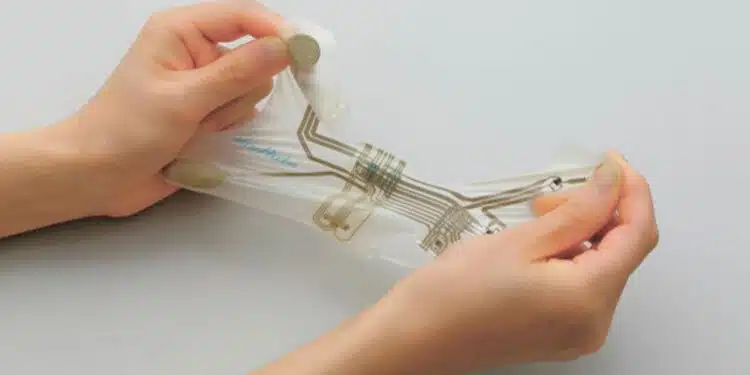Murata Manufacturing Co., Ltd reveals an innovative new Stretchable Printed Circuit (SPC) technology marking a significant development in printed circuit technology.
Murata’s SPC represents the next advancement in substrate development, providing both flexibility and the capability to stretch and deform while maintaining full functionality. It is perfect for creating advanced medical products, like wearable therapeutic devices and vital monitoring tools, that can provide better accuracy, durability, and patient comfort than today’s equivalent devices.
In recent years, in the medical field, to make more accurate diagnoses, the importance of sophisticated tests performed in hospitals and biometric information collected continuously in daily life has increased.
Daily vital sign monitoring is important to prevent lifestyle-related diseases, therefore wearable medical devices are now ubiquitous. However, existing devices are often too stiff for many applications, creating issues like patient discomfort, poor surface contact, or unstable data acquisition. Murata’s SPC excels in its inherent flexibility, stretchability, and ability to adapt, supporting multi-sensing functionalities to address diverse user requirements.
The material is incredibly soft and gentle on the skin, making it ideal for medical and wellness devices like EEG (Electroencephalogram), EMG (Electromyogram), and ECG(Electrocardiogram). Its stretchable nature can enable a single device to accommodate various body areas and patients of different sizes, as well as allowing more easily for continuous monitoring applications or monitoring in previously challenging areas such as elbows or knee joints.
Engineered with cutting-edge capabilities, including printing stretchable electrodes compliant with ANSI/AAMI EC12 standards, SPC paves the way for next-generation medical devices. It achieves seamless integration and optimal performance through innovative telescopic component mounting and hybrid bonding technology between substrates. By effectively blocking electromagnetic noise, the unique shield layer offers reliable protection for the signal path. Additionally, the substrate construction demonstrates excellent reliability, with high resistance to moisture and the ability to withstand high voltages for long durations, while allowing for more flexibility in component mounting, giving designers more freedom to innovate.
Murata’s SPC can be tailored to meet individual customer specifications with the help of Murata’s extensive range of resources to facilitate collaborative product development. This can be harnessed by product designers, enabling them to optimize their designs. Murata can further support development by conducting tests in various conditions and resolving failure modes by identifying their root causes. Depending on the required specifications, filters, amplifiers, and multiple sensors can be mounted on a single sheet, enabling accurate data acquisition and sensing of several items. With this solution, Murata performs custom design, prototyping and verification, and mass production based on the required specifications.
For further details or to request samples of Murata’s SPC solutions, you can contact your local Murata representation, or reach out via the contact form. You can find the product webpage here.
































